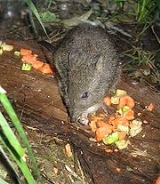
Spinifex Hopping Mouse
Overview
The Spinifex Hopping Mouse (Notomys alexis), also known as the Tarkawara or Tarrkawarra, occurs throughout the central and western Australia
n arid zones, occupying both spinifex
-covered sand flats and stabilised sand dunes, and loamy mulga
and melaleuca
flats.
The population fluctuates greatly: in normal years it is sparsely distributed and probably confined to sandy country; after rain the population explodes and spreads to other types of habitat for a time.
They are mostly seen at night, bounding across open ground on their large hind feet, with tails extended and the body almost horizontal.
The appearance is very similar to the Northern Hopping Mouse
: a little larger than a common House Mouse
at 95 millimetre head-body length and an average weight of 35 g (1.2 oz).
Australia
Australia , officially the Commonwealth of Australia, is a country in the Southern Hemisphere comprising the mainland of the Australian continent, the island of Tasmania, and numerous smaller islands in the Indian and Pacific Oceans. It is the world's sixth-largest country by total area...
n arid zones, occupying both spinifex
Triodia (plant genus)
Triodia is a large genus of hummock-forming grass endemic to Australia; they are commonly known as spinifex, although they are not a part of the coastal genus Spinifex. There are currently 64 recognised species...
-covered sand flats and stabilised sand dunes, and loamy mulga
Mulga
Acacia aneura, commonly known as Mulga or True Mulga, is a shrub or small tree native to arid outback Australia of areas such as the Western Australian Mulga shrublands.-Description:...
and melaleuca
Melaleuca
Melaleuca is a genus of plants in the myrtle family Myrtaceae known for its natural soothing and cleansing properties. There are well over 200 recognised species, most of which are endemic to Australia...
flats.
The population fluctuates greatly: in normal years it is sparsely distributed and probably confined to sandy country; after rain the population explodes and spreads to other types of habitat for a time.
They are mostly seen at night, bounding across open ground on their large hind feet, with tails extended and the body almost horizontal.
The appearance is very similar to the Northern Hopping Mouse
Northern Hopping Mouse
The Northern Hopping Mouse, Souris Sauteuse, or Ratones Saltadores De Australia is a species of rodent in the family Muridae. It is found only in coastal northern Australia, from Arnhem Land to the Cobourg Peninsula....
: a little larger than a common House Mouse
House mouse
The house mouse is a small rodent, a mouse, one of the most numerous species of the genus Mus.As a wild animal the house mouse mainly lives associated with humans, causing damage to crops and stored food....
at 95 millimetre head-body length and an average weight of 35 g (1.2 oz).

